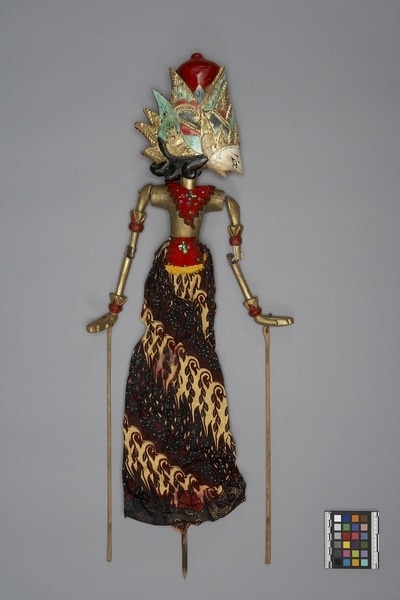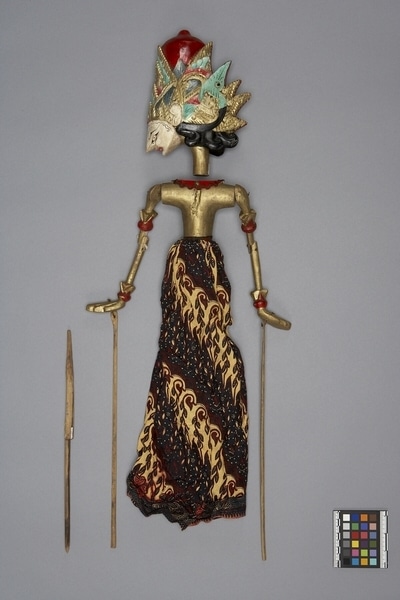Rod Puppet Item Number: Ib397 a-c from the MOA: University of British Columbia


Description
Three-dimensional male humanoid puppet: large head (part b) fits into body with skirt (part a), and a control rod (part c) with a long shaft that passes through the body and fits into the neck of the figure's head. The body has jointed arms, each with a long controlling rod attached. Discoloured white face positioned downwards with straight pointed nose, pink lips and white teeth. Hair, slight moustache, eyes outlined in black. Red crown (mahkota) headdress with tiered diadem (jamang) in gold, red, and green. Gold kurawista surrounds grey field; small grey triangular extension above. Gold sumping, two badong, and green Garuda Mungkur (short tongued) with wide black Tali Garuda. Long black hair falls in three curls. Gold neck and torso; arms have gold and red ornaments at biceps and wrists. Hands held flat and bent back at wrist. Red chest covering and apron with brown wavy trim, sequins and beads. Apron has red waistband and yellow fringe at bottom (both discoloured). Long batik skirt in beige with blue and red.
History Of Use
Javanese puppetry as an art form probably developed by the 11th century. Wayang golek puppets of western Java appeared during the 16th century. Originally the plays depicted Javanese mythology, but after the Indian conquest of Java the Hindu epics, Ramayana and Mahabharata, were incorporated into the cycles, which comprise about 200 plays. A dalang (puppet master) performs the plays to celebrate important occasions, usually in three acts, with vocal and instrumental accompaniment. Typically they serve a moral and religious purpose, and more recently, one of political commentary. Some characters have several different puppet representations, which vary to denote a change in the character's state, mood, or role. This puppet is evidently such a variant, depicting Rama, the major protagonist and incarnation of the god Vishnu in the Ramayana cycle of legends. He is at various times a prince (raden) and a king (prabu, as portrayed here).
Iconographic Meaning
Each puppet is characterized by its wanda, a Javanese word which describes the specific mixture of elements of size, form, colour, ornamentation and carving. Colour and position of face suggests a noble and virtuous character. Other indications of refinement are: delicate facial features, batik skirt, position of hands and arm ornaments, and gold skin. Crown identifies character as a king (prabu) or god (betara). Large size of puppet suggests latter. Puppet very closely resembles standard form of Rama; it is probably a manifestation (crown and face match standard, but moustache, less hair, and moustache are clearly variant) of Rama.
Cultural Context
Theatrical performance.
Item History
- Made in Java, Indonesia
- Owned by Donald Bone before January 4, 1980
- Received from Donald Bone (Seller) and Museum of Anthropology Donations Fund (Funding source) on January 4, 1980
What
- Name
- Rod Puppet
- Identification Number
- Ib397 a-c
- Type of Item
- puppet
- Material
- cotton fibre, paint, fibre and wood
- Manufacturing Technique
- carved, tied, woven, sewn and painted
- Part A
- height 56.5 cm, width 18.0 cm, depth 6.7 cm
- Part B
- height 21.0 cm, width 7.0 cm, depth 17.0 cm
- Part C
- height 33.0 cm, width 1.5 cm, depth 1.3 cm
Who
- Culture
- Sundanese
- Previous Owner
- Donald Bone
- Received from
- Donald Bone (Seller) and Museum of Anthropology Donations Fund (Funding source)
Where
- Holding Institution
- MOA: University of British Columbia
- Made in
- Java, Indonesia
When
- Ownership Date
- before January 4, 1980
- Acquisition Date
- on January 4, 1980
Other
- Condition
- fair
- Accession Number
- 0586/0016 a-c